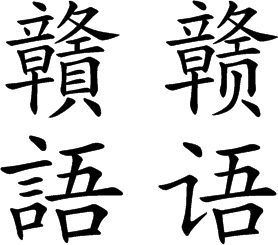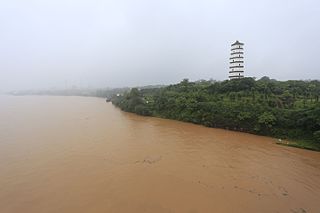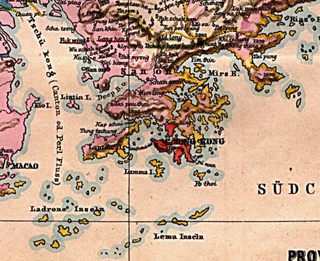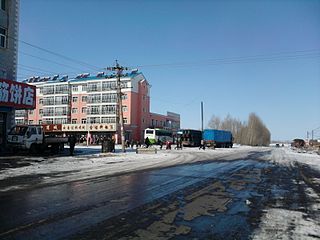
Jiangxi is a province in the People's Republic of China, located in the southeast of the country. Spanning from the banks of the Yangtze river in the north into hillier areas in the south and east, it shares a border with Anhui to the north, Zhejiang to the northeast, Fujian to the east, Guangdong to the south, Hunan to the west, and Hubei to the northwest.

The Songhua River is one of the primary rivers of China, and the largest tributary of the Amur River. It flows about 1,434 kilometres (891 mi) from the Changbai Mountains on the China–North Korea border through China's northeastern Jilin and Heilongjiang provinces. The river drains 557,180 square kilometres (215,130 sq mi) of land, and has an annual discharge of 2,463 cubic metres per second (87,000 cu ft/s).

The Daur people are a Mongolic-speaking ethnic group in northeastern China. The Daurian form one of the 56 ethnic groups officially recognised in the People's Republic of China. They numbered 131,992 according to the latest census (2010), and most of them live in Morin Dawa Daur Autonomous Banner in Hulun Buir, Inner Mongolia and Meilisi Daur District in Qiqihar, Heilongjiang of China. There are also some near Tacheng in Xinjiang, where their ancestors were moved during the Qing Dynasty.

Qiqihar is the second largest city in the Heilongjiang province of China, located in the west central part of the province. The built-up area made up of Longsha, Tiefeng and Jianhua districts had 979,517 inhabitants, while the total population of the prefecture-level city was 5,367,003 at the 2010 census. These are mainly Han Chinese, though the city is also home to thirty-four minorities including Manchus, Daur, and Mongols. Close to Qiqihar are numerous wetlands and the Zhalong Nature Reserve, famous in China for being home to numerous red-crowned cranes.

Gan is a group of Chinese varieties spoken as the native language by many people in the Jiangxi province of China, as well as significant populations in surrounding regions such as Hunan, Hubei, Anhui, and Fujian. Gan is a member of the Sinitic languages of the Sino-Tibetan language family, and Hakka is the closest Chinese variety to Gan in terms of phonetics.

The Gan River travels 885 km (550 mi) north through the western part of Jiangxi before flowing into Lake Poyang and thence into the Yangtze River. The Xiang-Gan uplands separate it from the Xiang River of neighbouring eastern Hunan.

Sungkiang or Songjiang was a province of the Republic of China. Mudanjiang was the capital. It was one of nine provinces created in Manchuria by the Chinese Nationalist government after World War II. Since the Nationalists never gained effective control of Manchuria, the province existed only on paper. It was bordered on the east by the USSR, and along part of the southern border ran the Nen (Nonni) and Songhua Rivers. In 1949 Hejiang was incorporated into Songjiang and in 1954, northern Songjiang was merged into Heilongjiang province and southern parts into Jilin province.

Enping, formerly romanized as Yanping, is a county-level city in Guangdong province, China, administered as part of the prefecture-level city of Jiangmen.

Wanzai County is a county under the administration of the prefecture-level city of Yichun in the northwest of Jiangxi province, China, bordering Hunan province to the west. The name Wanzai literally means "10,000 years". It could also mean"10,000 loads" and could likely be related to its past importance as a center of trade. It is located along the Long He or Dragon River, a tributary of the main river of the province, the Gan River. It has an area of 1,718 km2 (663 sq mi) and a population of 460,000.

The Wanshan Archipelago, formerly known as the Ladrones Islands, is a 104-island archipelago that is part of the Xiangzhou District of Zhuhai in Guangdong Province, China.
The Northeast China Plain, also known as the Manchurian Plain, is located in Northeast China. It lies between the Greater and Lesser Khingan and Changbai mountains. Covering 350,000 km2, it is China's largest plain, with an elevation of lower than 200 meters. The Songhua, Nen, and Liao rivers run through its vast and fertile land. The Manchurian plain of Asia is the other name of Amur valley.

Jishui is a county located on the Gan River in Ji'an city, Jiangxi province, China.

Aihui District is an administrative district and the seat of the prefecture-level city of Heihe, Heilongjiang Province, People's Republic of China. It is located on the right (south-western) bank of the Amur River, across which is Blagoveshchensk, Amur Oblast, Russia. According to the prefectural government, the land area of Aihui District is 1,443 km2 (557 sq mi), the population is 197,240 people.

Meilisi Daur District is an outlying district of the city of Qiqihar, Heilongjiang Province, China.

Shenqiu County is a county in the east of Henan province, China, bordering Anhui province to the south and east. It is under the administration of Zhoukou City. The county seat is the town of Shenqiu, which is situated on the Ying River, a tributary of the Huai River. This river traverses the county from Zhoukou in the west to the Henan state border with Anhui in the east at Jieshou,

Morin Dawa Daur Autonomous Banner is one of three autonomous banners in Inner Mongolia, People's Republic of China, created for the Daur people. It lies on the Nen River, borders Heilongjiang province to the east, south, and southwest, and is under the administration of Hulunbuir City.

Nenjiang–Greater Khingan Forest railway or Nenlin railway, is a single-track railroad in northeastern China between Nenjiang and the town of Gulian, in Mohe County. It is also known as the Nenjiang–Mohe railway or Nenmo railway (嫩漠铁路). Both of the railway's terminals are located in Heilongjiang Province. In between, the line traverses the Greater Khingan range of Inner Mongolia. Much of the line is located within the jurisdiction of the Greater Khingan Forest District, a special forestry prefecture that covers parts of both Inner Mongolia and Heilongjiang.
Guo Gan is an erhu musician from Shenyang, China now based in Paris, France. Gan was recognized as a Knight of the Order of Arts and Letters in 2016.


















